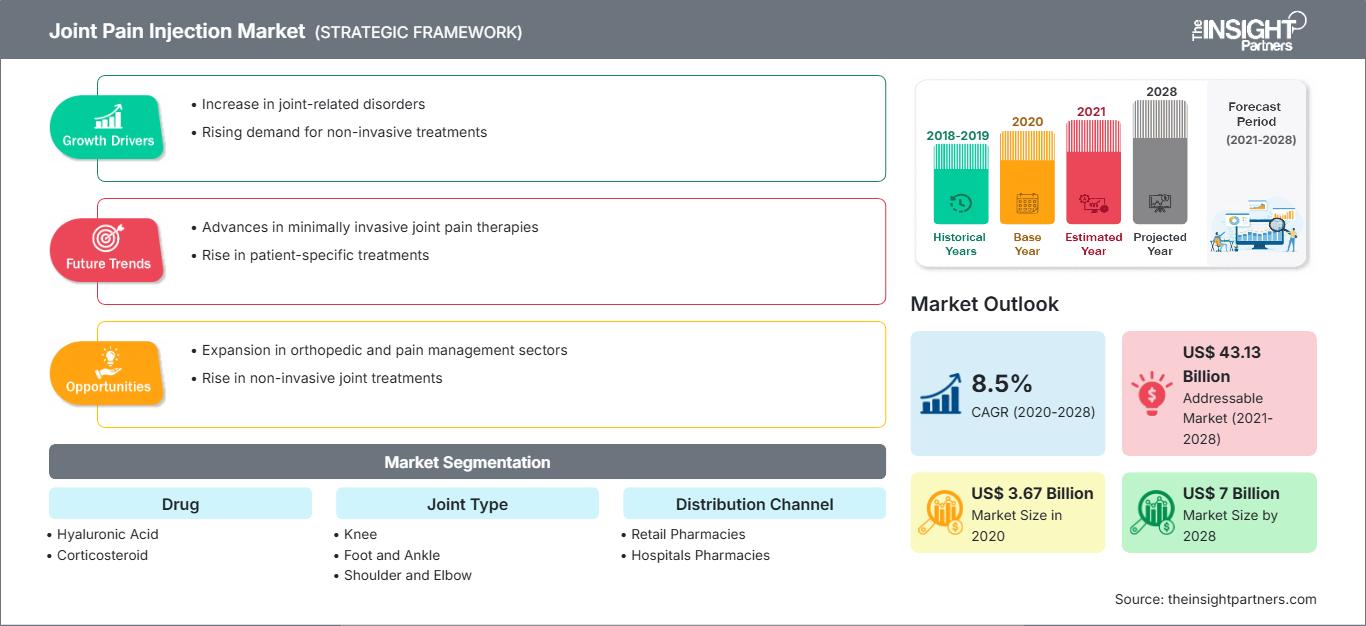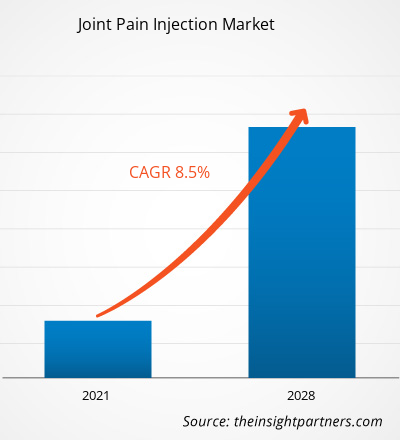[Rapporto di ricerca]Si prevede che il mercato delle iniezioni per il dolore articolare raggiungerà i 6.996,88 milioni di dollari entro il 2028, rispetto ai 3.667,45 milioni di dollari del 2020; si stima una crescita a un CAGR dell'8,5% tra il 2021 e il 2028.
Le iniezioni per il dolore articolare forniscono un sollievo più rapido dal dolore intenso e riducono l'infiammazione delle articolazioni. Diversi tipi di iniezioni disponibili sul mercato includono iniezioni di corticosteroidi, iniezioni di acido ialuronico (HA), iniezioni di plasma ricco di piastrine (PRP) e iniezioni di matrice tissutale placentare (PTM). La crescita del mercato delle iniezioni per il dolore articolare è attribuita a fattori quali l'elevata prevalenza di disturbi muscoloscheletrici e il crescente numero di infortuni sportivi. Tuttavia, gli elevati costi delle terapie di riparazione delle articolazioni ostacolano la crescita del mercato
Approfondimenti di mercato
Alta prevalenza di disturbi muscoloscheletrici
Personalizza questo rapporto in base alle tue esigenze
Potrai personalizzare gratuitamente qualsiasi rapporto, comprese parti di questo rapporto, o analisi a livello di paese, pacchetto dati Excel, oltre a usufruire di grandi offerte e sconti per start-up e università
Mercato delle iniezioni per il dolore articolare: Approfondimenti strategici

-
Ottieni le principali tendenze chiave del mercato di questo rapporto.Questo campione GRATUITO includerà l'analisi dei dati, che vanno dalle tendenze di mercato alle stime e alle previsioni.
I disturbi muscoloscheletrici sono condizioni mediche che colpiscono muscoli, ossa e articolazioni di collo, spalle, polsi, schiena, fianchi, gambe, ginocchia e piedi. Queste patologie includono tendinite, sindrome del tunnel carpale, osteoartrite, artrite reumatoide (AR), fibromialgia e fratture ossee. Secondo la scheda informativa dell'Organizzazione Mondiale della Sanità (OMS) aggiornata nel 2018, i disturbi muscoloscheletrici rappresentano la seconda causa di disabilità a livello mondiale. Si prevede inoltre che la prevalenza e l'impatto dei disturbi muscoloscheletrici aumenteranno con l'invecchiamento della popolazione e l'aumento della prevalenza dei fattori di rischio delle malattie non trasmissibili (MNT) in tutto il mondo. Secondo i dati del congresso annuale dell'American Academy of Orthopedic Surgeons del 2016, circa 1 adulto su 2 soffre di un disturbo muscoloscheletrico negli Stati Uniti. Inoltre, secondo i Centers for Disease Control and Prevention (CDC), l'artrite causa forti dolori che colpiscono milioni di persone negli Stati Uniti ogni anno. Circa un paziente su quattro affetto da artrite, ovvero circa 15 milioni su un totale di circa 54 milioni di pazienti, soffre di forti dolori articolari correlati all'artrite.
Inoltre, l'osteoartrite (OA) è una delle patologie articolari più comuni negli Stati Uniti, causata dalla rottura della cartilagine articolare tra le ossa. È anche nota come malattia degenerativa delle articolazioni o artrite da "usura". Secondo i Centers for Disease Control and Prevention (CDC), oltre 32,5 milioni di adulti negli Stati Uniti soffrono di osteoartrite. Analogamente, secondo il Servizio Sanitario Nazionale (NHS), oltre 10 milioni di persone nel Regno Unito soffrono di artrite o altre patologie simili che colpiscono le articolazioni. Secondo Bupa Health Insurance, l'osteoartrite è la forma di artrite più comune nel Regno Unito e colpisce circa un terzo delle persone di età pari o superiore a 45 anni, ovvero circa 8,75 milioni di persone. Pertanto, l'elevata prevalenza di disturbi muscoloscheletrici in diversi paesi sta aumentando il numero di procedure di trattamento eseguite per tali disturbi, stimolando così la crescita del mercato delle iniezioni per il dolore articolare.
Approfondimenti basati sui farmaci
Il mercato delle iniezioni per il dolore articolare, per farmaco, è segmentato in acido ialuronico, corticosteroidi e altri. Il segmento dei corticosteroidi ha detenuto la quota maggiore del mercato nel 2020 e si prevede che registrerà il CAGR più elevato durante il periodo di previsione.
Approfondimenti basati sul tipo di articolazione
In base al tipo di articolazione, il mercato delle iniezioni per il dolore articolare è segmentato in ginocchio, piede e caviglia, spalla e gomito, anca e altre applicazioni. Il segmento del ginocchio ha detenuto la quota di mercato maggiore nel 2020 e si prevede che registrerà il CAGR più elevato sul mercato durante il periodo di previsione.
Iniezione per il dolore articolare
Approfondimenti regionali sul mercato delle iniezioni per il dolore articolare
Le tendenze regionali e i fattori che influenzano il mercato delle iniezioni per il dolore articolare durante il periodo di previsione sono stati ampiamente spiegati dagli analisti di The Insight Partners. Questa sezione illustra anche i segmenti e la geografia del mercato delle iniezioni per il dolore articolare in Nord America, Europa, Asia-Pacifico, Medio Oriente e Africa, America meridionale e centrale.
Ambito del rapporto di mercato sulle iniezioni per il dolore articolare
| Attributo del rapporto | Dettagli |
|---|---|
| Dimensioni del mercato in 2020 | US$ 3.67 Billion |
| Dimensioni del mercato per 2028 | US$ 7 Billion |
| CAGR globale (2020 - 2028) | 8.5% |
| Dati storici | 2018-2019 |
| Periodo di previsione | 2021-2028 |
| Segmenti coperti |
By Farmaco
|
| Regioni e paesi coperti |
Nord America
|
| Leader di mercato e profili aziendali chiave |
|
Densità degli operatori del mercato delle iniezioni per il dolore articolare: comprendere il suo impatto sulle dinamiche aziendali
Il mercato delle iniezioni per il dolore articolare è in rapida crescita, trainato dalla crescente domanda da parte degli utenti finali, dovuta a fattori quali l'evoluzione delle preferenze dei consumatori, i progressi tecnologici e una maggiore consapevolezza dei benefici del prodotto. Con l'aumento della domanda, le aziende stanno ampliando la propria offerta, innovando per soddisfare le esigenze dei consumatori e sfruttando le tendenze emergenti, alimentando ulteriormente la crescita del mercato.

- Ottieni il Mercato delle iniezioni per il dolore articolare Panoramica dei principali attori chiave
Approfondimenti basati sul canale di distribuzione
In base al canale di distribuzione, il mercato delle iniezioni per il dolore articolare è segmentato in farmacie al dettaglio, farmacie ospedaliere e altri. Il segmento della cura delle ferite ha detenuto la quota di mercato maggiore nel 2020 e si stima che il segmento degli innesti ossei registrerà il CAGR più elevato sul mercato durante il periodo di previsione.
Il lancio e l'approvazione di nuovi prodotti sono le strategie comunemente adottate dalle aziende per espandere la propria presenza globale e il proprio portafoglio prodotti. Inoltre, gli operatori del mercato delle iniezioni per il dolore articolare si concentrano sulla strategia di collaborazione per ampliare la propria clientela, il che, a sua volta, consente loro di mantenere il proprio marchio a livello globale.
Mercato delle iniezioni per il dolore articolare - per farmaco
- Acido ialuronico
- Corticosteroidi
- Altri
Mercato delle iniezioni per il dolore articolare - per farmaco per tipo di articolazione
- Ginocchio
- Piede e caviglia
- Spalla e gomito
- Anca
- Altri
Mercato delle iniezioni per il dolore articolare - per canale di distribuzione
- Farmacie al dettaglio
- Farmacie ospedaliere
- Altri
Mercato delle iniezioni per il dolore articolare - per Geografia
-
Nord America
- Stati Uniti
- Canada
- Messico
-
Europa
- Francia
- Germania
- Italia
- Regno Unito
- Spagna
- Resto d'Europa
-
Asia Pacifico (APAC)
- Cina
- India
- Corea del Sud
- Giappone
- Australia
- Resto dell'Asia Pacifico
-
Medio Oriente e Africa (MEA)
- Sudafrica
- Arabia Saudita
- Emirati Arabi Uniti
- Resto del Medio Oriente e Africa
-
America Meridionale e Centrale (TRUFFA)
- Brasile
- Argentina
- Resto del Sud e Centro America
Profili aziendali
- Chugai Pharmaceutical Co., Ltd.
- Bioventus Inc.
- Fidia Pharma USA Inc.
- Flexion Therapeutics, Inc.
- SEIKAGAKU CORPORATION
- Ferring BV
- Sanofi
- Anika Therapeutics, Inc.
- Teva Pharmaceutical
- OrthogenRx, Inc.
- Analisi storica (2 anni), anno base, previsione (7 anni) con CAGR
- Analisi PEST e SWOT
- Valore/volume delle dimensioni del mercato - Globale, Regionale, Nazionale
- Industria e panorama competitivo
- Set di dati Excel
Report recenti
Testimonianze
Motivo dell'acquisto
- Processo decisionale informato
- Comprensione delle dinamiche di mercato
- Analisi competitiva
- Analisi dei clienti
- Previsioni di mercato
- Mitigazione del rischio
- Pianificazione strategica
- Giustificazione degli investimenti
- Identificazione dei mercati emergenti
- Miglioramento delle strategie di marketing
- Aumento dell'efficienza operativa
- Allineamento alle tendenze normative






















 Ottieni un campione gratuito per - Mercato delle iniezioni per il dolore articolare
Ottieni un campione gratuito per - Mercato delle iniezioni per il dolore articolare